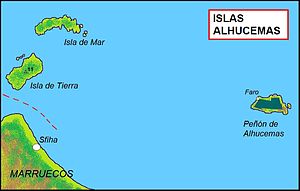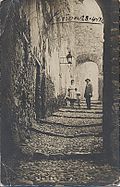| This article needs additional citations for verification. Please help improve this article by adding citations to reliable sources. Unsourced material may be challenged and removed. Find sources: "Alhucemas Islands" – news · newspapers · books · scholar · JSTOR (January 2013) (Learn how and when to remove this message) |
| Disputed island | |
|---|---|
 Map of the Ahucemas Islands Map of the Ahucemas Islands | |
| Geography | |
| Location | Alboran Sea |
| Coordinates | 35°12′54″N 3°53′46″W / 35.215°N 3.896°W / 35.215; -3.896 |
| Total islands | 3 |
| Administration | |
| Claimed by | |



The Alhucemas Islands (Spanish: Islas Alhucemas, Arabic: جزر الحسيمة) is a group of islands and one of the Spanish plazas de soberanía just off the Moroccan coast in the Alboran Sea.
Overview
Peñón de Alhucemas, together with the islets of Isla de Mar and Isla de Tierra slightly to the west, form the Alhucemas Islands. They are located 300 metres (984 feet) off the Moroccan town of Al Hoceima, or Alhucemas (former Villa Sanjurjo), 146 km (91 miles) east of Ceuta and 84 km (52 miles) west of Melilla. The aggregate land area of the group of three islands is 4.6 ha or 0.046 square kilometres (0.018 sq mi).
- Peñón de Alhucemas (Spanish pronunciation: [peˈɲon de aluˈθemas], "Lavender Rock", 35°12′49″N 3°53′22″W / 35.2135°N 3.8895°W / 35.2135; -3.8895 (Peñón de Alhucemas)) is a tiny rock island, measuring 220 m (722 ft) east-west and up to 84 m (276 ft) north-south, with an area 1.5 ha or 0.015 km (0.006 sq mi), and a height of 27 m (89 ft). The rock is entirely occupied by a fort, several houses, and a church. It is one of several peñones, or rock-fortresses, off the coast of Northern Africa.
- Isla de Tierra (35°12′55″N 3°54′09″W / 35.2152°N 3.9026°W / 35.2152; -3.9026 (Isla de Tierra)) is a steep, 11 m (36 ft) high rocky platform, 114 m (374 ft) north of the Moroccan beach, 192 m (630 ft) long northeast–southwest, and up to 87 m (285 ft) wide, yielding an area of 1.7 ha or 0.017 km (0.007 sq mi).
- Isla de Mar (35°13′03″N 3°54′03″W / 35.2176°N 3.9008°W / 35.2176; -3.9008 (Isla de Mar)) is a flat, 4 m (13 ft) high islet, with its western end 93 m (305 ft) north of Isla de Tierra, 245 m (804 ft) long east–west, up to 70 m (230 ft) wide, yielding an area of 1.4 ha or 0.014 km (0.005 sq mi).

Spanish rule dates back to 1559, when the Saadis ceded several territories to Spain in exchange for Spanish help against Ottoman armies. In 1673, Spain sent a garrison to the island of Peñón de Alhucemas, and has permanently occupied it since then. The islands are also located near the landing place the Spanish and French expeditionary forces used in 1925 during the Rif War. Morocco has contested Spanish sovereignty over the islets since Morocco received its independence in 1956.
In 2012 the Spanish military garrison in the fort on Peñón de Alhucemas comprised an infantry section of 25–30 men from the 32nd Mixed Artillery Regiment, plus personnel from the marine services with an inflatable boat for reaching supply vessels.
On 29 August 2012, 19 sub-Saharan immigrants traversed the short expanse of water between Morocco and the Isla de Tierra. These individuals camped on the island, hoping to somehow gain access into the Spanish mainland. They were shortly joined by an additional 68 immigrants on 2 September 2012. Refugees and illegal immigration from sub-Saharan nations has been a problem that Spain, and the European Union as a whole, has been trying to solve. Since the islets had an "undefined internal status", the immigrants did not benefit from the Spanish immigration laws and, under a joint operation, Spanish troops tended to the women, children, and medical needs of the immigrants, then turned them back over to Morocco. Moroccan forces promptly deported the individuals across the Algerian border. The Spanish Army has since stationed a small camp on the Isla de Tierra to discourage new attempts to illegally cross into Spanish territory. The handling and deportation of these individuals have been criticized by the Ombudsman of the Spanish Parliament, the Defensor del Pueblo, and by various NGOs and organizations.
See also
References
- ^ Ceberia, Monica et al (17 September 2012) The last remains of the empire El Pais in English, Retrieved 24 September 2012
- Ceberio Balaza, Monica, et al (7 September 2012) 81 inmigrantes tratan de forzar su entrada en España por Isla de Tierra (81 immigrants try to force entrance into Spain via the Isla de Tierra) El Pais Politica (in Spanish), Retrieved 24 September 2012
- Ceberio Balaza, Monica (7 September 2012) El Ejército ‘ocupa’ Isla de Tierra (The army "occupies" Isla de Tierra El Pais Politica (in Spanish), Retrieved 24 September 2012
- Diez, Anabel et al (6 Sep 2012) La Defensora pide aclaraciones a Interior por la entrega de inmigrantes a Marruecos (The Ombudsman asks for clarification from the Interior Ministry concerning the delivery of immigrants to Morocco) El Pais Politica (in Spanish), Retrieved 24 September 2012
| Autonomous communities of Spain | ||
|---|---|---|
| Autonomous communities | ||
| Autonomous cities | ||
| Plazas de soberanía | ||
| Outlying territories of European countries | |
|---|---|
| Territories under European sovereignty but closer to or on continents other than Europe (see inclusion criteria for further information). | |
| Denmark | |
| France | |
| Netherlands | |
| Norway | |
| Portugal | |
| Spain | |
| United Kingdom | |
| Countries and territories of North Africa | |||||||||||||||||
|---|---|---|---|---|---|---|---|---|---|---|---|---|---|---|---|---|---|
| Sovereign states | |||||||||||||||||
| Partially recognized state | |||||||||||||||||
| Territories |
| ||||||||||||||||
| Entirely claimed by both Morocco and the SADR. Spanish exclaves claimed by Morocco. Portuguese archipelago claimed by Spain. Disputed between Egypt and the Sudan. Unclaimed territory located between Egypt and the Sudan. Disputed between South Sudan and the Sudan. Part of Chad, formerly claimed by Libya. Disputed between Morocco and Spain | |||||||||||||||||